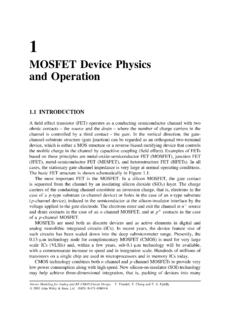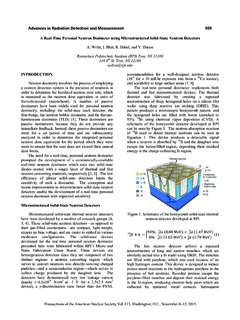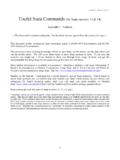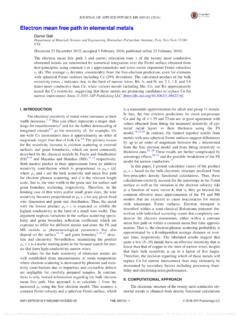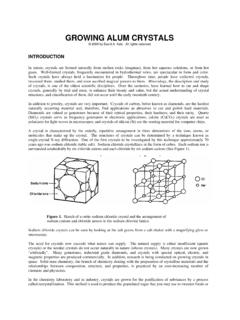Transcription of FTIR and DSC of polymer films used for packaging: …
1 1 FTIR and DSC of polymer films used for packaging : LLDPE, PP and PVDC John Petrovich SHAPE American High School Abstract: Polymers are compounds used in various materials. There are a plethora of methods used to analyze the composition and other properties of the material; these include Fourier Transform Infrared Spectroscopy (FTIR) and Differential Scanning Calorimetry (DSC). The profiles of the DSC display varying melting peaks and glass transition regions for different samples. This indicates that DSC can be used to determine different qualities of polymeric materials which include, but are not limited to, high density character, low density character, amorphousness, and semi crystallinity. We found from the DSC profile that the melting point for various polyethylene samples range from approximately 120-130 degrees C.
2 The DSC profile for the polypropylene (PP) shows peaks at 163 and 156 degrees C at the main and secondary melting peaks respectively. The DSC profile for Stretch-Tite does not even have melting peaks. It instead has glass transition regions found at approximately 60 and 95 degrees C. The lack of a melting peak in the polyvinylidene chloride (PVDC) sample is indicative of an amorphous polymer . Introduction: polymer films are extensively used commercial packaging . Species used in packaging include, but are not limited to polyester (PET), polyamide, polyvinyl chloride (PVC), polystyrene (PS), polypropylene (PP) and polyethylene (PE). Polyethylene can form with different densities. These include low density (LDPE), linear low density (LLDPE), medium density (MDPE), high density (HDPE), and ultra-high density (UHDPE).
3 It is possible for samples of LLDPE to take on characteristics of either LDPE or HDPE. Polymers can exist in two different morphologies while in a solid phase: o Amorphous: Molecules are randomly oriented within the polymer . These polymers can easily be altered in shape and generally exist in a rubbery state. o Semi crystalline: An arrangement of ordered molecules with some amorphous regions. These polymers are stiff and exist in a glassy state. This paper is focused on answering the following hypotheses: Hypothesis: Can we utilize DSC and FTIR data to determine why different LLDPE samples exhibit properties similar to either LDPE or HDPE? Can one identify whether a polymer material is crystalline or amorphous based upon DSC melting temperature data?
4 2 Samples: The pictures of the polymeric material samples that we used in this experiment are shown in figure 1. These samples are used in the physical state seen in the pictures. (a) (b) (c) (d) (e) (f) Figure 1: (a) Ziplock Sandwich Bags, (b) PE-LD bag with recycling code 4, (c) Glad wrap with adhesive side, (d) Act II popcorn bags, (e) Stretch-Tite Saran Wrap, (f) Walmart Bag Differential Scanning Calorimetry (DSC): DSC is a method of analysis that allows the user to measure glass transition, melting temperature, and crystallization temperature while a polymeric material sample is being heated or cooled.
5 Each polymer film tested had a specific melting and recrystallization point that was reflected in the DSC as an endothermic and exothermic peak, respectively. During our research, we subjected various samples through a heating phase, a cooling phase, and another heating phase. We used a TA Instruments DSC (Model Q2000) using low mass Aluminum sample pans and a sample weight with a mass of approximately 2-3 milligrams. The polyvinyl chloride sample was heated/cooled at a rate of 20 degrees centigrade per minute. All other samples were heated/cooled at a rate of 10 degrees centigrade per minute. For the data analysis of the DSC profiles, TA Universal Analysis 2000 was used . Fourier Transform Infrared Spectroscopy (FTIR): FTIR is a spectroscopic method of analysis where IR rays are absorbed by bonds in a molecule.
6 These IR ray s energy can be related to the vibrational energy of different bonds found within different functional groups in a compound. To provide a few examples, one might 3 be able to find a relatively large O-H peak at approximately 3500-3200 cm-1. Another prominent example that can be seen in a plethora of polymer samples in the carbonyl functional group peak (C=O) which occurs at about 1690 1820 cm-1. Peaks in lower energy areas on an FTIR graph are collectively known as the fingerprint region. Each region is unique for an individual compound and are thus extremely helpful in comparisons between different FTIR graphs. The exact model used in this research was the Perkin Elmer (Model Spectrum Two) for taking spectrum data in the wavelength range of 4000-7000 cm-1.
7 Samples were prepared by cutting 3 cm in diameter from each film and taping it to a Rensselaer Summer Program business card. Results: FTIR: The first portion of my research involved placing my samples into a FTIR spectrophotometer in hopes of revealing differences in functional groups between the various polymers. The following IR spectra are from those that I prepared with the assistance of various teacher s assistants: (a) Ziplock Bag (PE) (b) Bag PE-LD (PE) (c) Glad Wraps with Adhesive (PE) (d) Walmart Bag (PE) 4 (e) Act II Popcorn Wrapper (PP) (f) Stretch-Tite Wrap (PVDC) FTIR spectra from previously published polymer chemistry literature is seen below.
8 Due to a lack of HDPE or LDPE specific LLDPE FTIR spectra, comparison with the samples above was done with regular HDPE and LDPE spectra: Low Density Polyethylene: 5 High Density Polyethylene: Polypropylene: 6 Polyvinylidene Chloride Comparing my LLDPE-LDPE IR spectra with the example from previous literature, one might tell that the same functional groups are present, but their respective peaks are of slightly different proportions. One must recognize that the comparison is between LLDPE-LDPE and LDPE, and a differentiation in the amount of branching in both samples accounts for some of the different proportions in peaks. Another reason for this might be due to the fact that our experimental samples had color additives within them.
9 This particular possible source of error can be seen when the peak is fatter than the established reference. Something similar occurs when comparing the experimental LLDPE-HDPE samples with the established reference from previous literature. This is particularly evident in the Walmart Bag sample. The aromatic C-H peak approximately at 2900 cm-1 is particularly thick when compared to findings of the European Commission. This thickness is due to the grey color additives found in the Walmart bag. The experimentally determined IR spectrum for PP that we generated varied a great deal from the spectrum from the other literature. Most of the same functional groups are still present, but there are distinct curves in the profile that are not present from the spectrum generated by the European Commission.
10 These curves are due to the sample that we used being of a relatively high thickness. It is also worth mentioning a strange fingerprint region not present in the reference spectrum. This could possibly be due to additives or contamination, a much less likely possibility considering the sample had been disinfected in a Suprasil ozone/UV oven. When one compares the LLDPE-HDPE and LLDPE-LDPE spectra, they lack any noticeable difference in structure. The only exception would be the inclusion of additional thickness/length to peaks due to additional branching in some samples. In a similar manner, FTIR didn t provide much information concerning levels of crystallinity of polypropylene and polyvinylidene chloride besides its structure.
